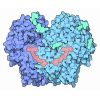+ Open data
Open data
- Basic information
Basic information
| Entry | Database: PDB / ID: 6vhh | ||||||||||||
|---|---|---|---|---|---|---|---|---|---|---|---|---|---|
| Title | Human Teneurin-2 and human Latrophilin-3 binary complex | ||||||||||||
 Components Components |
| ||||||||||||
 Keywords Keywords | MEMBRANE PROTEIN / Adhesion GPCR / synapse / Teneurin / Lphn | ||||||||||||
| Function / homology |  Function and homology information Function and homology informationretrograde trans-synaptic signaling by trans-synaptic protein complex / Rho-activating G protein-coupled receptor signaling pathway / cell adhesion mediator activity / excitatory synapse assembly / : / positive regulation of filopodium assembly / neuron development / synapse assembly / cell adhesion molecule binding / filopodium ...retrograde trans-synaptic signaling by trans-synaptic protein complex / Rho-activating G protein-coupled receptor signaling pathway / cell adhesion mediator activity / excitatory synapse assembly / : / positive regulation of filopodium assembly / neuron development / synapse assembly / cell adhesion molecule binding / filopodium / molecular condensate scaffold activity / cell-cell adhesion / G protein-coupled receptor activity / PML body / adenylate cyclase-activating G protein-coupled receptor signaling pathway / neuron migration / cell-cell junction / cell junction / growth cone / carbohydrate binding / dendritic spine / postsynaptic membrane / cell surface receptor signaling pathway / neuron projection / G protein-coupled receptor signaling pathway / protein heterodimerization activity / signaling receptor binding / axon / calcium ion binding / synapse / dendrite / glutamatergic synapse / endoplasmic reticulum / negative regulation of transcription by RNA polymerase II / Golgi apparatus / signal transduction / protein homodimerization activity / nucleus / membrane / plasma membrane Similarity search - Function | ||||||||||||
| Biological species |  Homo sapiens (human) Homo sapiens (human) | ||||||||||||
| Method | ELECTRON MICROSCOPY / single particle reconstruction / cryo EM / Resolution: 2.97 Å | ||||||||||||
 Authors Authors | Xie, Y. / Li, J. / Arac, D. / Zhao, M. | ||||||||||||
| Funding support |  United States, 3items United States, 3items
| ||||||||||||
 Citation Citation |  Journal: Nat Commun / Year: 2020 Journal: Nat Commun / Year: 2020Title: Alternative splicing controls teneurin-latrophilin interaction and synapse specificity by a shape-shifting mechanism. Authors: Jingxian Li / Yuan Xie / Shaleeka Cornelius / Xian Jiang / Richard Sando / Szymon P Kordon / Man Pan / Katherine Leon / Thomas C Südhof / Minglei Zhao / Demet Araç /  Abstract: The trans-synaptic interaction of the cell-adhesion molecules teneurins (TENs) with latrophilins (LPHNs/ADGRLs) promotes excitatory synapse formation when LPHNs simultaneously interact with FLRTs. ...The trans-synaptic interaction of the cell-adhesion molecules teneurins (TENs) with latrophilins (LPHNs/ADGRLs) promotes excitatory synapse formation when LPHNs simultaneously interact with FLRTs. Insertion of a short alternatively-spliced region within TENs abolishes the TEN-LPHN interaction and switches TEN function to specify inhibitory synapses. How alternative-splicing regulates TEN-LPHN interaction remains unclear. Here, we report the 2.9 Å resolution cryo-EM structure of the TEN2-LPHN3 complex, and describe the trimeric TEN2-LPHN3-FLRT3 complex. The structure reveals that the N-terminal lectin domain of LPHN3 binds to the TEN2 barrel at a site far away from the alternatively spliced region. Alternative-splicing regulates the TEN2-LPHN3 interaction by hindering access to the LPHN-binding surface rather than altering it. Strikingly, mutagenesis of the LPHN-binding surface of TEN2 abolishes the LPHN3 interaction and impairs excitatory but not inhibitory synapse formation. These results suggest that a multi-level coincident binding mechanism mediated by a cryptic adhesion complex between TENs and LPHNs regulates synapse specificity. | ||||||||||||
| History |
|
- Structure visualization
Structure visualization
| Movie |
 Movie viewer Movie viewer |
|---|---|
| Structure viewer | Molecule:  Molmil Molmil Jmol/JSmol Jmol/JSmol |
- Downloads & links
Downloads & links
- Download
Download
| PDBx/mmCIF format |  6vhh.cif.gz 6vhh.cif.gz | 362.4 KB | Display |  PDBx/mmCIF format PDBx/mmCIF format |
|---|---|---|---|---|
| PDB format |  pdb6vhh.ent.gz pdb6vhh.ent.gz | 264.1 KB | Display |  PDB format PDB format |
| PDBx/mmJSON format |  6vhh.json.gz 6vhh.json.gz | Tree view |  PDBx/mmJSON format PDBx/mmJSON format | |
| Others |  Other downloads Other downloads |
-Validation report
| Summary document |  6vhh_validation.pdf.gz 6vhh_validation.pdf.gz | 1.5 MB | Display |  wwPDB validaton report wwPDB validaton report |
|---|---|---|---|---|
| Full document |  6vhh_full_validation.pdf.gz 6vhh_full_validation.pdf.gz | 1.5 MB | Display | |
| Data in XML |  6vhh_validation.xml.gz 6vhh_validation.xml.gz | 63 KB | Display | |
| Data in CIF |  6vhh_validation.cif.gz 6vhh_validation.cif.gz | 95.3 KB | Display | |
| Arichive directory |  https://data.pdbj.org/pub/pdb/validation_reports/vh/6vhh https://data.pdbj.org/pub/pdb/validation_reports/vh/6vhh ftp://data.pdbj.org/pub/pdb/validation_reports/vh/6vhh ftp://data.pdbj.org/pub/pdb/validation_reports/vh/6vhh | HTTPS FTP |
-Related structure data
| Related structure data |  21205MC M: map data used to model this data C: citing same article ( |
|---|---|
| Similar structure data |
- Links
Links
- Assembly
Assembly
| Deposited unit | 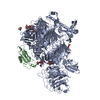
|
|---|---|
| 1 |
|
- Components
Components
-Protein , 2 types, 2 molecules AB
| #1: Protein | Mass: 216254.578 Da / Num. of mol.: 1 Source method: isolated from a genetically manipulated source Source: (gene. exp.)  Homo sapiens (human) / Gene: TENM2, KIAA1127, ODZ2, TNM2 / Cell line (production host): Hi5 / Production host: Homo sapiens (human) / Gene: TENM2, KIAA1127, ODZ2, TNM2 / Cell line (production host): Hi5 / Production host:  Trichoplusia ni (cabbage looper) / References: UniProt: Q9NT68 Trichoplusia ni (cabbage looper) / References: UniProt: Q9NT68 |
|---|---|
| #2: Protein | Mass: 95209.586 Da / Num. of mol.: 1 Source method: isolated from a genetically manipulated source Source: (gene. exp.)  Homo sapiens (human) / Gene: ADGRL3, KIAA0768, LEC3, LPHN3 / Cell line (production host): Hi5 / Production host: Homo sapiens (human) / Gene: ADGRL3, KIAA0768, LEC3, LPHN3 / Cell line (production host): Hi5 / Production host:  Trichoplusia ni (cabbage looper) / References: UniProt: Q9HAR2 Trichoplusia ni (cabbage looper) / References: UniProt: Q9HAR2 |
-Sugars , 4 types, 8 molecules 
| #3: Polysaccharide | alpha-D-mannopyranose-(1-4)-2-acetamido-2-deoxy-beta-D-glucopyranose-(1-4)-2-acetamido-2-deoxy-beta- ...alpha-D-mannopyranose-(1-4)-2-acetamido-2-deoxy-beta-D-glucopyranose-(1-4)-2-acetamido-2-deoxy-beta-D-glucopyranose Source method: isolated from a genetically manipulated source | ||
|---|---|---|---|
| #4: Polysaccharide | beta-D-mannopyranose-(1-4)-2-acetamido-2-deoxy-beta-D-glucopyranose-(1-4)-2-acetamido-2-deoxy-beta- ...beta-D-mannopyranose-(1-4)-2-acetamido-2-deoxy-beta-D-glucopyranose-(1-4)-2-acetamido-2-deoxy-beta-D-glucopyranose Source method: isolated from a genetically manipulated source | ||
| #5: Polysaccharide | Source method: isolated from a genetically manipulated source #6: Sugar | |
-Details
| Has ligand of interest | N |
|---|---|
| Has protein modification | Y |
-Experimental details
-Experiment
| Experiment | Method: ELECTRON MICROSCOPY |
|---|---|
| EM experiment | Aggregation state: PARTICLE / 3D reconstruction method: single particle reconstruction |
- Sample preparation
Sample preparation
| Component | Name: Binary complex of human Teneurin-2 with human Latrophilin-3 extracellular domain Type: COMPLEX Details: The binary complex includes human Teneurin2 (TENM2) (Teneurin without alternative splice sequence NKEFKHS) and human Latrophilin3 (LPHN3/ADGRL3) with an alternative splice sequence KVEQK ...Details: The binary complex includes human Teneurin2 (TENM2) (Teneurin without alternative splice sequence NKEFKHS) and human Latrophilin3 (LPHN3/ADGRL3) with an alternative splice sequence KVEQK between lectin domain and olfactomedin domain. Entity ID: #1-#2 / Source: RECOMBINANT |
|---|---|
| Molecular weight | Value: 0.314 MDa / Experimental value: YES |
| Source (natural) | Organism:  Homo sapiens (human) Homo sapiens (human) |
| Source (recombinant) | Organism:  Trichoplusia ni (cabbage looper) / Cell: Hi5 Trichoplusia ni (cabbage looper) / Cell: Hi5 |
| Buffer solution | pH: 8.5 |
| Specimen | Conc.: 2.2 mg/ml / Embedding applied: NO / Shadowing applied: NO / Staining applied: NO / Vitrification applied: YES |
| Specimen support | Grid material: COPPER / Grid mesh size: 300 divisions/in. / Grid type: Quantifoil R1.2/1.3 |
| Vitrification | Instrument: FEI VITROBOT MARK IV / Cryogen name: ETHANE / Humidity: 100 % / Chamber temperature: 281.15 K |
- Electron microscopy imaging
Electron microscopy imaging
| Experimental equipment |  Model: Titan Krios / Image courtesy: FEI Company |
|---|---|
| Microscopy | Model: FEI TITAN KRIOS |
| Electron gun | Electron source:  FIELD EMISSION GUN / Accelerating voltage: 300 kV / Illumination mode: FLOOD BEAM FIELD EMISSION GUN / Accelerating voltage: 300 kV / Illumination mode: FLOOD BEAM |
| Electron lens | Mode: BRIGHT FIELD / Nominal magnification: 81000 X / Cs: 2.7 mm / C2 aperture diameter: 100 µm |
| Specimen holder | Specimen holder model: FEI TITAN KRIOS AUTOGRID HOLDER |
| Image recording | Average exposure time: 4.2 sec. / Electron dose: 60.1 e/Å2 / Film or detector model: GATAN K3 BIOQUANTUM (6k x 4k) / Num. of real images: 5402 |
- Processing
Processing
| EM software |
| ||||||||||||||||||||||||
|---|---|---|---|---|---|---|---|---|---|---|---|---|---|---|---|---|---|---|---|---|---|---|---|---|---|
| CTF correction | Details: CTF correction was done in Relion reconstruction / Type: PHASE FLIPPING ONLY | ||||||||||||||||||||||||
| Particle selection | Num. of particles selected: 4475958 | ||||||||||||||||||||||||
| Symmetry | Point symmetry: C1 (asymmetric) | ||||||||||||||||||||||||
| 3D reconstruction | Resolution: 2.97 Å / Resolution method: FSC 0.143 CUT-OFF / Num. of particles: 436208 / Symmetry type: POINT | ||||||||||||||||||||||||
| Refinement | Stereochemistry target values: GeoStd + Monomer Library + CDL v1.2 | ||||||||||||||||||||||||
| Displacement parameters | Biso mean: 52.62 Å2 | ||||||||||||||||||||||||
| Refine LS restraints |
|
 Movie
Movie Controller
Controller



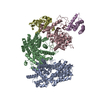
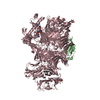

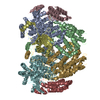





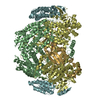
 PDBj
PDBj




